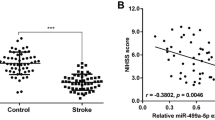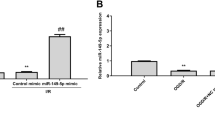Abstract
Ischemic stroke is a nervous system disease with high rates of disability and mortality. MicroRNAs have been reported to modulate cerebral ischemia. The current study aimed to study the role of miR-361-3p in cerebral ischemia–reperfusion (I/R) injury. Experimental results revealed that miR-361-3p level was downregulated in a middle cerebral artery occlusion-induced ischemic stroke mouse model and in oxygen–glucose deprivation/reoxygenation-stimulated SH-SY5Y cells. After overexpressing miR-361-3p, the percentage of brain infarct volume and neurobehavioral scores in mice were significantly reduced, and the neuronal apoptosis was inhibited. Moreover, miR-361-3p overexpression could limit the production of reactive oxygen species (ROS). Furthermore, we investigated the underlying molecular mechanisms of miR-361-3p and identified that miR-361-3p combined with NACC1 3ʹUTR to negatively modulate its expression. In addition, NACC1 interacts with the PINK1/Parkin pathway in neurons. NACC1 overexpression could rescue the impacts of miR-361-3p mimics on cell apoptosis, ROS production and the PINK1/Parkin pathway. In conclusion, miR-361-3p could improve ischemia brain injury by targeting NACC1 through the PINK1/Parkin pathway. Therefore, miR-361-3p may serve as a potential therapeutic target for the brain injury after I/R.




Similar content being viewed by others
References
Adeoye O, Hornung R, Khatri P, Kleindorfer D (2011) Recombinant tissue-type plasminogen activator use for ischemic stroke in the United States: a doubling of treatment rates over the course of 5 years. Stroke 42:1952–1955. https://doi.org/10.1161/strokeaha.110.612358
Bingol B, Sheng M (2016) Mechanisms of mitophagy: PINK1, Parkin, USP30 and beyond. Free Radic Biol Med 100:210–222. https://doi.org/10.1016/j.freeradbiomed.2016.04.015
Domitrz I, Kosiorek M, Żekanowski C, Kamińska A (2016) Genetic studies of Polish migraine patients: screening for causative mutations in four migraine-associated genes. Hum Genomics 10:3. https://doi.org/10.1186/s40246-015-0057-8
Donnan GA, Howells DW, Markus R, Toni D, Davis SM (2003) Can the time window for administration of thrombolytics in stroke be increased? CNS Drugs 17:995–1011. https://doi.org/10.2165/00023210-200317140-00001
Duarte FV, Palmeira CM, Rolo AP (2015) The emerging role of MitomiRs in the pathophysiology of human disease. InmicroRNA 888:123–154. https://doi.org/10.1007/978-3-319-22671-2_8
Eiyama A, Okamoto K (2015) PINK1/Parkin-mediated mitophagy in mammalian cells. Curr Opin Cell Biol 33:95–101. https://doi.org/10.1016/j.ceb.2015.01.002
Fan Y et al (2019) Intravenous thrombolysis is safe and effective for the cryptogenic stroke in china: data from the thrombolysis implementation and monitor of acute ischemic stroke in China (TIMS-China). J Stroke Cerebrovasc Dis 28:220–226. https://doi.org/10.1016/j.jstrokecerebrovasdis.2018.09.041
Feng J et al (2018) Naringin attenuates cerebral ischemia-reperfusion injury through inhibiting peroxynitrite-mediated mitophagy activation. Mol Neurobiol 55:9029–9042. https://doi.org/10.1007/s12035-018-1027-7
Fritsch LE, Moore ME, Sarraf SA, Pickrell AM (2019) Ubiquitin and receptor dependent mitophagy pathways and their implication in neurodegeneration. J Mol Biol 432:2510–2524. https://doi.org/10.1016/j.jmb.2019.10.015
He J, Zhang X, He W, Xie Y, Chen Y, Yang Y, Chen R (2021) Neuroprotective effects of zonisamide on cerebral ischemia injury via inhibition of neuronal apoptosis. Braz J Med Biol Res 54:e10498. https://doi.org/10.1590/1414-431x202010498
Jeyaseelan K, Lim KY, Armugam A (2008) MicroRNA expression in the blood and brain of rats subjected to transient focal ischemia by middle cerebral artery occlusion. Stroke 39:959–966. https://doi.org/10.1161/strokeaha.107.500736
Jia L, Hao F, Wang W, Qu Y (2015) Circulating miR-145 is associated with plasma high-sensitivity C-reactive protein in acute ischemic stroke patients. Cell Biochem Funct 33:314–319. https://doi.org/10.1002/cbf.3116
Jiang C et al (2018) Long noncoding RNA (lncRNA) HOTAIR affects tumorigenesis and metastasis of non-small cell lung cancer by upregulating miR-613. Oncol Res 26:725–734. https://doi.org/10.3727/096504017x15119467381615
Jin Q et al (2018) DUSP1 alleviates cardiac ischemia/reperfusion injury by suppressing the Mff-required mitochondrial fission and Bnip3-related mitophagy via the JNK pathways. Redox Biol 14:576–587. https://doi.org/10.1016/j.redox.2017.11.004
Kabekkodu SP, Shukla V, Varghese VK, D’Souza J, Chakrabarty S, Satyamoorthy K (2018) Clustered miRNAs and their role in biological functions and diseases. Biol Rev 93:1955–1986. https://doi.org/10.1111/brv.12428
Korutla L, Furlong HA, Mackler SA (2014) NAC1, A POZ/BTB protein interacts with Parkin and may contribute to Parkinson’s disease. Neuroscience 257:86–95. https://doi.org/10.1016/j.neuroscience.2013.11.001
Lago TS, Silva JA, Lago EL, Carvalho EM, Zanette DL (2018) The miRNA 361–3p, a regulator of GZMB and TNF is associated with therapeutic failure and longer time healing of Cutaneous Leishmaniasis Caused by L (viannia) braziliensis. Front Immunol 9:2621. https://doi.org/10.3389/fimmu.2018.02621
Liu L, Zuo Y, Xu Y, Zhang Z, Li Y, Pang JJC (2019a) MiR-613 inhibits proliferation and invasion and induces apoptosis of rheumatoid arthritis synovial fibroblasts by direct down-regulation of DKK1. Cell Mol Biol Lett 24:8. https://doi.org/10.1186/s11658-018-0130-0
Liu X, Feng Z, Du L, Huang Y, Ge J, Deng Y, Mei Z (2019b) The potential role of MicroRNA-124 in cerebral ischemia injury. Int J Mol Sci 21:120. https://doi.org/10.3390/ijms21010120
MacFarlane LA (2010) MicroRNA: biogenesis, function and role in cancer. Curr Genomics 11:537–561. https://doi.org/10.2174/138920210793175895
McWilliams TG, Muqit MM (2017) PINK1 and Parkin: emerging themes in mitochondrial homeostasis. Curr Opin Cell Biol 45:83–91. https://doi.org/10.1016/j.ceb.2017.03.013
Miao W, Bao TH, Han JH, Yin M, Zhang J, Yan Y, Zhu YH (2016) Neuroprotection induced by post-conditioning following ischemia/reperfusion in mice is associated with altered microRNA expression. Mol Med Rep 14:2582–2588. https://doi.org/10.3892/mmr.2016.5576
Nakayama N, Kato H, Sakashita G, Nariai Y, Nakayama K, Kyo S, Urano T (2016) Protein complex formation and intranuclear dynamics of NAC1 in cancer cells. Arch Biochem Biophys 606:10–15. https://doi.org/10.1016/j.abb.2016.07.007
Nastasi DR, Smith JR, Moxon JV, Trollope A, Golledge J (2018) Prescription of pharmacotherapy and the incidence of stroke in patients with symptoms of peripheral artery disease. Stroke 49:2953–2960. https://doi.org/10.1161/STROKEAHA.118.022922
Schoch K et al (2017) A recurrent de novo variant in NACC1 causes a syndrome characterized by infantile epilepsy cataracts, and profound developmental delay. Am J Hum Genet 100:343–351. https://doi.org/10.1016/j.ajhg.2016.12.013
Sekine J et al (2015) Nucleus accumbens-associated protein 1 expression has potential as a marker for distinguishing oral epithelial dysplasia and squamous cell carcinoma. PLoS ONE 10:e0131752. https://doi.org/10.1371/journal.pone.0131752
Song M, Gong G, Burelle Y, Gustafsson ÅB, Kitsis RN, Matkovich SJ, Dorn GW (2015) Interdependence of Parkin-mediated mitophagy and mitochondrial fission in adult mouse hearts. Circ Res 117:346–351. https://doi.org/10.1161/CIRCRESAHA.117.306859
Wang H, Li M, Cui H, Song X, Sha Q (2020) CircDHDDS/miR-361-3p/WNT3A axis promotes the development of retinoblastoma by regulating proliferation cell cycle, migration, and invasion of retinoblastoma cells. Neurochem Res. https://doi.org/10.1007/s11064-020-03112-0
Wang H et al (2020) LncRNA MALAT1 silencing protects against cerebral ischemia-reperfusion injury through miR-145 to regulate AQP4. J Biomed Sci 27:40. https://doi.org/10.1186/s12929-020-00635-0
Wu X et al (2018) Hydrogen exerts neuroprotective effects on OGD/R damaged neurons in rat hippocampal by protecting mitochondrial function via regulating mitophagy mediated by PINK1/Parkin signaling pathway. Brain Res 1698:89–98. https://doi.org/10.1016/j.brainres.2018.06.028
Xia Q, Li X, Zhou H, Zheng L, Shi J (2018) S100A11 protects against neuronal cell apoptosis induced by cerebral ischemia via inhibiting the nuclear translocation of annexin A1. Cell Death Dis 9:657. https://doi.org/10.1038/s41419-018-0686-7
Xie YL, Zhang B (2018) MiR-125b blocks Bax/Cytochrome C/Caspase-3 apoptotic signaling pathway in rat models of cerebral ischemia-reperfusion injury by targeting p53. Neurol Res 40:828–837. https://doi.org/10.1080/01616412.2018.1488654
Xiong L et al (2020) Overexpression of miR-124 protects against neurological dysfunction induced by neonatal hypoxic-ischemic brain injury. Cell Mol Neurobiol 40:737–750. https://doi.org/10.1007/s10571-019-00769-2
Xu FF, Zhang ZB, Wang YY, Wang TH (2018) Brain-derived glia maturation factor β participates in lung injury induced by acute cerebral ischemia by increasing ROS in endothelial cells. Neurosci Bull 34:1077–1090. https://doi.org/10.1007/s12264-018-0283-x
Yao X, Yao R, Yi J (2019) Upregulation of miR-496 decreases cerebral ischemia/reperfusion injury by negatively regulating BCL2L14. Neurosci Lett 696:197–205. https://doi.org/10.1016/j.neulet.2018.12.039
Ye RS et al (2017) miR-361–3p regulates FSH by targeting FSHB in a porcine anterior pituitary cell model. Reproduction (cambridge, England) 153:341–349. https://doi.org/10.1530/rep-16-0373
Yeasmin S et al (2012) Biological and clinical significance of NAC1 expression in cervical carcinomas: a comparative study between squamous cell carcinomas and adenocarcinomas/adenosquamous carcinomas. Hum Pathol 43:506–519. https://doi.org/10.1016/j.humpath.2011.05.021
Zhang X, He X, Liu Y, Zhang H, Chen H, Guo S, Liang Y (2017) MiR-101–3p inhibits the growth and metastasis of non-small cell lung cancer through blocking PI3K/AKT signal pathway by targeting MALAT-1. Biomed Pharmacother = Biomedecine & Pharmacotherapie 93:1065–1073. https://doi.org/10.1016/j.biopha.2017.07.005
Zhang Y et al (2020) TMEM16F aggravates neuronal loss by mediating microglial phagocytosis of neurons in a rat experimental cerebral ischemia and reperfusion model. Front Immunol 11:1144. https://doi.org/10.3389/fimmu.2020.01144
Zhong Z, Zhong W, Zhang Q, Zhang Q, Yu Z, Wu H (2020) Circulating microRNA expression profiling and bioinformatics analysis of patients with coronary artery disease by RNA sequencing. J Clin Lab Anal 34:e23020. https://doi.org/10.1002/jcla.23020
Zhou G et al (2018) Loss of Smad7 promotes inflammation in rheumatoid arthritis. Front Immunol 9:2537. https://doi.org/10.3389/fimmu.2018.02537
Zhu C, Chen G, Zhao Y, Gao X, Wang JJ (2018) Regulation of the development and function of B cells by ZBTB transcription factors. Front Immunol 9:580. https://doi.org/10.3389/fimmu.2018.00580
Zorov DB, Krasnikov BF, Kuzminova AE, Vysokikh MY, Zorova LD (1997) Mitochondria revisited. Alternative functions of mitochondria. BioSci Rep 17:507–520. https://doi.org/10.1023/a:1027304122259
Acknowledgements
We appreciate all participators.
Funding
This worked was supported by National Natural Science Foundation of China (No. 81401030) and Health Commission of Hubei Province scientific research project (No. WJ2021F114, WJ2021M181).
Author information
Authors and Affiliations
Corresponding authors
Ethics declarations
Conflict of interest
All the authors declared that they have no conflict of interest.
Additional information
Publisher's Note
Springer Nature remains neutral with regard to jurisdictional claims in published maps and institutional affiliations.
Supplementary Information
Below is the link to the electronic supplementary material.
Rights and permissions
About this article
Cite this article
Ye, X., Song, H., Hu, H. et al. MiR-361-3p alleviates cerebral ischemia–reperfusion injury by targeting NACC1 through the PINK1/Parkin pathway. J Mol Histol 53, 357–367 (2022). https://doi.org/10.1007/s10735-021-10049-3
Received:
Accepted:
Published:
Issue Date:
DOI: https://doi.org/10.1007/s10735-021-10049-3




